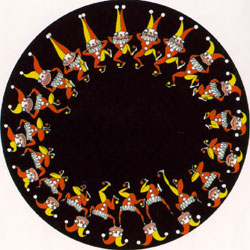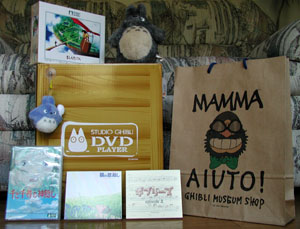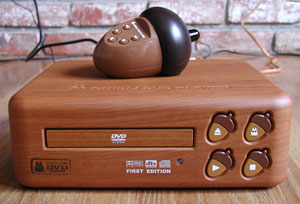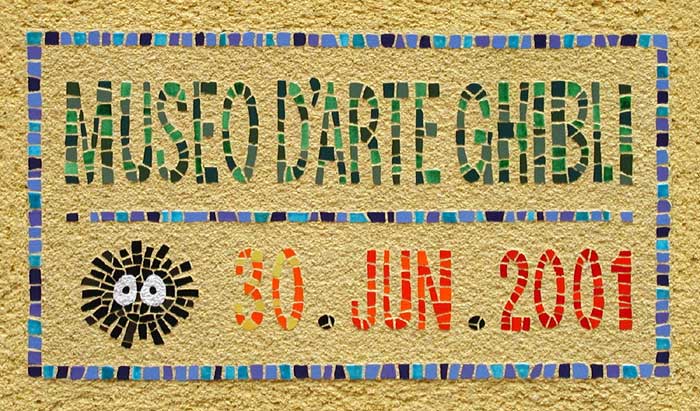The museum is in Mitaka, about 20 minutes from Shinjuku. Mitaka
is a really nice town - not like the hustling, bustling mess of
Tokyo. For example, there's a pleasant walkway along the river that
has some nice greenery along it; there's no room for trees in Tokyo.
We got out of the station and saw some signs pointing to the bus
to the museum. The bus was jammed with little kids, so we decided
to walk along the river. It's a nice walk and only a little over
a kilometer to the museum anyway.
The walkway has some helpful animal-headed signs pointing toward
the museum, telling how many more meters it is to the place.
So, after the pleasant walk, we see the ticket office:
Now, after finding the real way in (the place is only by advance
ticket purchase, anyway), we enter the amazing museum. We exchanged
the vouchers we got from the travel company for real tickets - including
a ticket (with three frames of embedded film!) for the current museum-only
short film, Koro no Oosanpo (Koro's Big Stroll - no idea what the
official English title is). Unfortunately, they didn't let you take
pictures inside the museum, so for the indoors exhibits I'll have
to use scans from the museum book.
We entered into the interestingly-designed museum and headed first
to the bathrooms (hey, it was a long train ride), but... the most
obvious way to them was through a door about 3 or 4 feet high...
On the main ground floor is a tiny spiral staircase (only barely
enough room for one person) up to the third floor... there're things
like mini-causeways across the upper floors... windows inside here
and there, doors of miscellaneous sizes... stained-glass windows
depicting Ghibli characters all over the place... even the fan at
the ceiling's blades were shaped like airplane wings.
 |
scan of Jesters
passing their heads |
|
Then we headed into the main gallery, where we saw first a model
of a robot from Laputa with one of those spinning cylinder things
with slits in it around it to make an animation of birds flying
from its hands (a big one - it went most of the way to the ceiling)...
and then a bunch of exhibits, a lot of which involving strobe lights
to make interesting animations... a memorable one involved a bunch
of court jester-type people on a spinning circle passing their heads
from one person to the next.
Then the most impressive exhibit - again involving strobe lights:
 |
scan of Spinning
model animation |
|
A whole bunch of models all attached around a pole in the center,
spinning quickly around it. Each model was right in line with the
next, so when a strobe light that was timed to hit each model exactly
as the next one was in front of the viewer, it created the illusion
of animation. There were animations of a bat flying, a Totoro jumping
with an umbrella, Mei jumping rope, a running catbus, someone on
a unicycle...
Then, on the second floor, there were lots of mock-ups of an animator's
studio, documenting all the parts of the process. They showed storyboarding
(they even let you flip through books with the complete storyboards
of all their films), drawing the backgrounds, the rack of paint
(hundreds of colors), the steps each cel had to go through to completion
(sketching, photocopying to create black lines, drawing in lines
to show where colors changed, painting in both colors separately).
 |
| |
The whole area's walls were covered with drawings, watercolors,
completed cels, they even drew things on the walls - windows showing
into a family of pigs having dinner, a (real) desk halfway into
the wall showed an animator working at it, complete with the rest
of the animators working behind him. There were stacks of books
everywhere too. There were some weird green models of (it looked
like) green, hunched-over midgets, almost like the three green heads
in Spirited Away, but these ones had bodies... they were sitting
in corners on the books.
There are some doors to the outside on this floor, leading to the
cafe, but I'll go there later, because I'm going in the order I
walked through the museum.
Then we headed up to the third floor - via the normal staircase,
not the narrow spiral one, primarily because the spiral one went
only from the first to the third floor with no stop at the second.
There was an interesting causeway above the staircase though - it
led from the top of the spiral staircase to the third floor, but
it went right above everybody on the staircase.
The third floor had another interesting large, furry creature:
a catbus with screaming kids romping all over it - with their shoes
off, of course. I wonder how long that thing lasts, considering
the level of activity on it... It seemed to be the place where the
little kids with their endless energy romped around while their
tired parents took a break at the surrounding benches.
 |
Spiral Staircase to the Roof
|
|
But wait! There's a door to the outside! From here, there's a view
of the entrance and of another spiral staircase going up.
Interesting that the whole building almost looks like a giant,
elaborate potted plant.
 |
Robot from Laputa
on the Roof |
|
 |
Block from Laputa
on the Roof |
|
But what could be on the roof? A giant casting of a robot from
Laputa: Castle in the Sky! There was a long line in front of the
robot with people waiting to get their picture taken in front of
it. A person was about as tall as a leg of the robot. There were
even plants growing in various places on the sculpture!
The whole outside of the museum seemed like a garden because of
the numbers of plants growing on and around it.
There was also a skylight on the roof, looking down into the fan
with the airplane wings. Also, there was also a model of one of
the cube-things from Laputa, off in the corner of the rooftop. (It
wasn't nearly as popular as the statue of the robot, though.)
Then, after returning to the third floor, we explored the rest
of the inside. There were a few rooms devoted to endless pictures
of the production of Spirited Away. There was even a huge stack
with piles and piles of (I believe) the cels to the movie. They
took up a giant glass case in the middle of the room. The walls
of the room had pictures from practically every scene to the movie.
There was also a gallery with framed cels of all of Studio Ghibli's
movies. Some were replicas that one could buy (for a lot of money)...
but others were originals on display.
 |
Stuff I bought
from the gift shop |
|
The gift shop (Called Mamma Aiuto) was also on this floor. At the
gift shop, you could buy so many different Ghibli-related things.
For example, they had puzzles, a large selection of stuffed animals
(including a Totoro backpack! cute!), Ghibli christmas tree ornaments,
movie soundtracks, videos, and DVDs, models of various characters
(including a die-cast version of the Laputa robot), figures on a
string with a suction cup to put on your car window, wash cloths
with characters on them, ... and so much more. A Ghibli fan's paradise...
but only if you have a lot of money, which I don't.
 |
| |
Since I went to the museum on the day of the release of Spirited
Away on DVD, I bought the movie there - but since I also did not
have a region 2 DVD player, I got the set with the Ghibli DVD player.
(It wasn't very much more expensive than buying a region-free one
here, due to the fact that the player set (¥19800, about $172)
came with the DVD, priced at ¥4700 (about $41). And I got a
... very interesting-looking ... DVD player in the bargain. It's
pretty small, too.
Also, the set came with Haku's onigiri figure, a plastic model
of the rice-ball that Haku gives Chihiro... I'm still scratching
my head as to why people would want this...
On the other side of the third floor - the bookstore. They had
all the Ghibli art books, as well as Japanese-translated classics
(Sherlock Holmes, Les Miserables, etc). They also had kids' books.
The most interesting book there was the Museum book - I bought a
copy. It documented (with lots of pictures!) the inside of the museum
where we weren't allowed to take pictures.
From here, we head back to the first floor to see the museum-only
short film about the little dog Koro and his adventures on a stroll.
The little dog gets lost in the process, with his little-girl owner
searching for him. A cute film. It had Japanese subtitles, complete
with imitations of what noises the dog was making, etc. The theater
was interesting - it had a painting of the sun on the ceiling, and
when they dimmed the lights for the movie to start, a moon covered
up the sun. Also, the windows automatically closed. (they were sort
of like airplane windows)
The tickets were also interesting - they had three frames of film
embedded in each. My scanner doesn't scan film, though, so even
after touching up in Photoshop, the frame isn't very good...
There are three museum-only films: Kujiratori, Koro no Oosanpo,
and Mei to konekobasu. We saw Koro no Oosanpo - the others show
at different times so they can get you to come back to the museum,
but I have very little chance of seeing the others unless they import
them to America.
After the film, we head back to the third floor to see if we missed
anything. We didn't, so...
Time to head out of the museum. We head down the staircase - the
atmosphere in here was a very cheerful yellow. But wait! there's
a door outside - but not out of the museum. This lead to the Cafe.
Unfortunately, the cafe had a very long line, so we went to the
hot dog stand (which also had a very long line, but it was moving
quicker). The menu and informational signs featured the typical
Miyazaki pigs.
Underneath the cafe area (the area accessible by stairs, shown
in the picture of the cafe), there were some lockers for your stuff,
as well as one of those religious water-purification things (with
a fountain w/ cups on handles that you wash your hands in...) I
have no idea what they're called, but even it had its own weathervane
with a figure of a pig on it!
|




